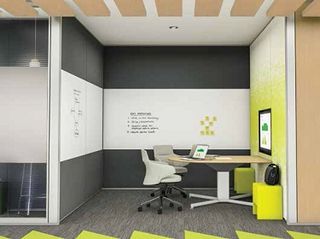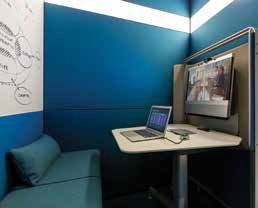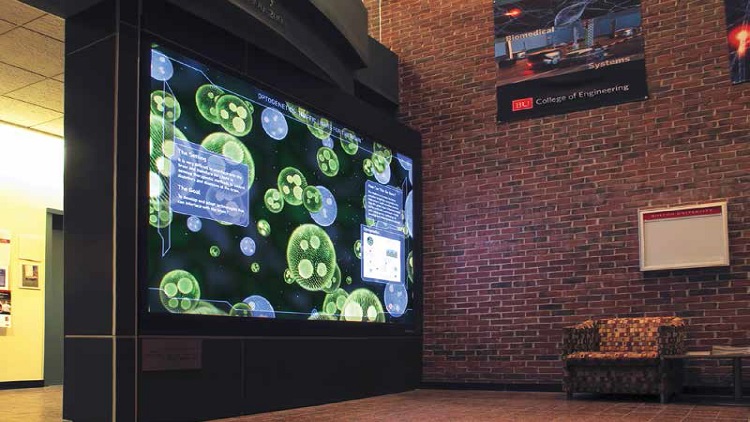Earlier this year, Prysm Inc., a collaboration solutions developer based in San Jose, Calif., commissioned Forrester Research to examine collaboration technology use in the enterprise. The study surveyed 1,000 professionals at organizations in the U.S. and U.K. working in companies with 1,000 employees or more. Two-hundred of those surveyed work in IT and facilities, and 800 are “information workers”—those who are actually supposed to be taking advantage of the benefits collaborations systems can offer during meetings.
It’s no secret that IT’s relationship with its user base isn’t always smooth sailing, and the Prysm/Forrester study is another example of these two communities not seeing eye to eye. While 51 percent of IT/facilities workers believe their organizations provide sufficient collaboration tools, only 26 percent of employees say this is the case. Forty-nine percent of IT/facilities pros attest there is adequate space in their companies’ offices for effective collaboration, again, only 26 percent of employees agree. And then there is the issue of glitches: 45 percent of workers say that in technology-enabled meeting environments, it’s hard to engage all participants.
If we agree with the concept that collaboration technology stands to facilitate innovation and boost productivity among far-flung professionals who are often working on a global landscape, or improve the teaching process for better student outcomes, the question is: how do we put this into practice in a meaningful way? (And, as a happy side effect, possibly bridge the gap between IT and end users?)
THINK ABOUT THE OBVIOUS STUFF
Mark Henkin, an expert in audio-visual systems for educational facilities at control and networking solutions manufacturer AMX by Harman in Richardson, Texas, noted that in providing environments that are conducive to collaboration, organizations need to think beyond the technology. He cites active learning classrooms as an example: commonly, schools will design their spaces to house a number of active learning pods made up of moveable tables. But tables are difficult to move around if they weren’t configured properly. “You think I’m joking when I say this, but I have been in spaces where they never move the tables because they didn’t put wheels on them,” he said. “That’s a basic thing.” He also adds that oftentimes those charged with space planning don’t consider what students bring into class. “They have coats, bags, books, and there is no storage under the chairs, no hooks on the walls.” Depending on the course—dentistry, for example—students may also be bringing tools and lab equipment.
MAKE SURE THEY CAN ACTUALLY SEE WHAT’S UP THERE
Another factor that has less to do with the technology itself and more to do with good space planning concerns displays. This spring, office technologies manufacturer Epson released a study conducted by Radial Global Market Research on how well students could read the content displayed on a 70-inch flat panel in a traditional 30-foot-by-30-foot classroom. Of the 102 students surveyed (ages ranged from 12 to 22), 58 percent were not able to read the content properly. “That’s a huge number,” said Remi Del Mar, senior product manager at Epson, “and it definitely impacts engagement.”
REMOTE WORKERS SHOULD BE TOP-OF-MIND

Prysm solutions are used by Wipro, an IT services, business, & tech consultancy. Wipro also offers IT outsourcing. One of the highlights of the Prysm/Forrester study is that when employees are working, they’re not necessarily at work in the traditional sense: 40 percent of respondents says they go into the office five days a week, which means the other 60 percent are working off-site regularly. From a collaboration perspective, this means that meeting the needs of remote participants so that they can contribute to sessions effectively is increasingly important. “When you talk about networked AV, in the past that’s meant linking conference rooms together and enabling [those in them] to collaborate more effectively,” said Paige O’Neill, chief marketing office at Prysm. “I think that remote access and enabling those employees to have the same experience—which is now very doable with the technology—is very important.”
COLLABORATION TECH TRAINING
O’Neill noted that when it comes to teaching users how to operate collaboration technology, the systems themselves offer a more appealing approach to training than what she calls “death by PowerPoint.” “You’re able to ensure that it’s an engaging experience because you’re leveraging modern technology to present in a more meaningful way,” she said. And, she adds, it’s also easier to get everybody up to speed, no matter where they are, thanks to cloud-based solutions. “When you’ve got a cohesive experience that can be replicated in multiple locations, you’re able to ensure consistency in training so that everyone’s getting the same message. I think that continuity of experience plus engagement brings a lot more to the table.”
NETWORKED AV: A NECESSITY?

Solutions from Steelcase (steelcase.com) encourage collaboration by offering flexible, ergonomic seating & tech usage. Many organizations are mandating networked AV simply because it cuts down on the hassle associated with troubleshooting and fixing problems. “We’re seeing control systems as being increasingly more important for remote maintenance because you don’t necessarily need outsourced staff or even on-campus staff to be in that room to perform troubleshooting or service calls,” Gina Sansivero, director of business development for the education market at FSR Inc., a conferencing solutions manufacturer based in Woodland Park, N.J., told AV Technology last year. “That really helps when an instructor is having problems and they’re able to call the help desk and the help desk can access that room via the control system at that moment, rather than having to wait for somebody to take a little golf cart across the campus and run in and disrupt the class.” Further, remote monitoring capabilities enable IT teams to predict issues and make fixes before equipment actually fails.
But while networked AV offers these benefits, it’s necessary for organizations to determine what they need it to achieve. “What is it they want the room to do? And why?” said Michael Yonks, director of SchoolView sales at AMX by Harman. “What is being put on the network?”
To answer these questions, the right people need to gather before the project is rolled out. “Network planning is the most important thing,” Henkin said. “You’ve got to bring the engineers to the table first.”

One of the main frustrations with networked AV is latency and dropped calls. Michael Johas Teener, senior technical director and plumbing architect at semiconductor manufacturer Broadcom, headquartered in Irvine, Calif., is one of the original founders of AVnu Alliance, which promotes the simplification of network synchronization through AVB and TSN through the issue of its own product certifications. “In a general IT-type network, there are inevitable delays in transmission and reception, and there are dropouts and changes in quality,” he said. “Using the technology we’ve developed gets around that so that we end up with deterministic delays and terministic quality assurances. And that moves a general IT network into something that’s a lot closer to the old-fashioned landline phone, where the quality is consistent and generally very good, and the delays are very low.” And, he noted, anytime you want people to interact effectively, paying attention to delays—or, more specifically, preventing them—is important.
Teener relays that AVnu is currently working with the Internet Engineering Task Force’s (IETF) Deterministic Networking (DetNet) Working Group to establish standards that will essentially make this possible using routers. “Once the standards are set for that, AVnu is going to provide the same kind of services, the same kind of compliance and interoperability so all of the suppliers know exactly which one of the features in a standard they actually want to implement, and how to do it in such a way that they’re interoperable,” he explained. “Once we do that, the size of the network can expand … with, of course, the intent that the internet as a whole could provide the delays and the deterministic timing that we’re talking about.” This, he says, would solve latency and quality issues that far-flung organizations face, especially if they don’t have a dedicated link between locations. “What this would do when we implement it within routers is it would allow the distribution networks to provide guarantees without all that manual setup. That will drop the cost.”
Carolyn Heinze is an AV Technology contributor.
Info
AMX BY HARMAN
www.amx.com
AVNU ALLIANCE
www.avnu.org
BROADCOM
www.broadcom.com
EPSON
www.epson.com
FSR INC.
www.fsrinc.com
PRYSM INC.
www.prysm.com










